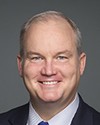Thank you very much, Mr. Chair. Thank you very much to the committee for allowing me to present to you and through you, Mr. Chair, to the members of the Ontario electoral boundaries commission. I truly appreciate their work. I know this is a hard task. It's like putting a jigsaw puzzle together and changing pieces all the time.
I have a modest proposal I'd like this committee to consider. I'll be able to hand out copies of this presentation to the committee shortly. My main request is to keep the municipality of Clarington whole. The largest community within my riding is the municipality of Clarington, with 85,000 residents. The commission has kept 15,000 of those people outside of the riding and in the Northumberland Riding.
With these changes, we're asking to keep Clarington whole. It's a growing community. It's in the Durham region. It's in the GTA. By taking the 15,000 people out, they're moving into a non-GTA, non-Durham region, more Eastern Ontario riding which they don't have historical ties with. This proposal is supported by the regional level of government in Durham, by the mayor, all council in Clarington and, as you'll see later, by a vast overwhelming majority of the population in Durham.
The next is to maintain the riding name as Durham. The proposed riding would be named Oshawa—Durham. There's clearly a stand-alone riding of Oshawa. My riding of Durham would only take a small portion of north Oshawa, and by not including the names of other communities in the riding, such as Clarington or Scugog, you're essentially excluding larger historic communities within the riding. By keeping the name Durham, it is a riding name description that is inclusive of all the communities within the riding. I think that should be the same, and historically, it has deep roots in Ontario and in Canada.
In order to keep our population in Durham to a manageable size, I'm also complementing the suggestion by my colleague, Colin Carrie, to keep more of Oshawa in his riding, particularly an area around the University of Ontario Institute of Technology. It's known as Oshawa's university. It works directly with Durham College in the south of Mr. Carrie's riding. By giving up a portion of Oshawa that the commission proposed come into Durham, I then have more room to keep Clarington whole, which is my overriding objective.
Here is the current riding compared to the proposal. The proposal makes some smart changes, but as I said, it misses keeping Clarington on the far right of the right photo.... It's not kept whole. There's a lot of consternation in the riding because of that.
Compared to the commission proposal and my counterproposal, you'll see we take a little smaller slice of urbanized Oshawa and we pick up the communities of Newtonville, Newcastle, and Orono to keep Clarington whole, to keep that largest municipality within the Durham riding whole. It's totally in line with section 15.2 of the act, which permits a community of history, a community of identity, a community of interest to be kept together. It's still within the population range provided by section 15 of the act. It is really just skirting a few streets of difference and giving those to Mr. Carrie, and even though his riding will be larger, it is also permitted by section 15 of the act.
I also held a riding survey that was advertised in all local newspapers. Of the respondents in the communities in eastern Clarington that would be taken out, overwhelmingly, 90% said that their community of interest and identity is with Clarington. That's an overwhelming number. Only 3% in the survey said that their community of interest was with Port Hope, the Northumberland riding. The highest response for riding name by the population in Durham was to maintain the Durham name. It's inclusive to all communities large and small within the riding and has historic roots.
With respect, Mr. Chair, and through you to the commission, these proposals are clearly in line with section 15. They're clearly intended to keep the community together, being Clarington, and to keep a riding name that reflects all residents of the riding, and within a population range clearly allowed for those very reasons.
Thank you.

